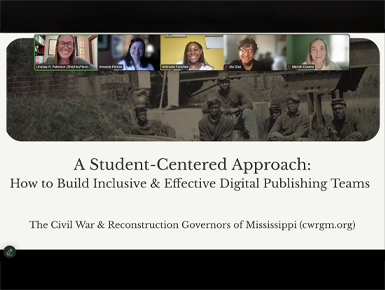USD University Libraries Members Present at the 2025 Library Publishing Coalition Conference

Presenters at the conference included Lindsey R. Peterson, Ph.D., M.A. ’15, digital humanities librarian and assistant professor of practice at USD; Mariah Cosens, an M.A. history student at USD; Amanda Patrick, a master of library and information science graduate from the University of Southern Mississippi; Amiracle Funches, a B.A. history graduate at Millsaps College; and Alessandra Diaz, a history and political science major at Columbia University.
Their presentation focused on how the CWRGM project gave them a unique opportunity to develop and refine their professional skills while showcasing the impact of their involvement in digital archiving, historical research and publishing.
CWRGM is a collaborative effort between USD, the University of Southern Mississippi (USM) and Mississippi State University. It aims to digitize and publish archival records sent to Mississippi governors during the Civil War and Reconstruction era (1859-1882), making them freely available online. The records, located at the Mississippi Department of Archives and History, feature letters written by ordinary people, offering a rare and invaluable insight into the social dynamics of the time.
Co-directed by Peterson and Susannah J. Ural, director of CWRGM, the project launched in 2020 at USM. The duo first connected during Peterson’s graduate studies at USM and, since then, the project has expanded to USD, where Peterson now serves as co-director.
Integrating Professional Development with Digital Humanities
Funded by grants, CWRGM has hired more than 60 students, who have been trained in deciphering and reading 19th-century cursive and the vocabulary of the time period.
“We try to do a lot of professional development opportunities,” said Peterson. “These positions give students hands-on training in digital humanities while they’re in school, so they obtain work experience that augments the classroom education they would receive in USD’s academic programs.”
Students working on the CWRGM index letters by applying controlled vocabulary to the transcripts. This task, however, demands a strong grasp of historical context. Student researchers must interpret historical texts with care, especially when the author’s meaning is ambiguous or when terminology has evolved. From there, they draft, transcribe and review the document, then upload it to the CWRGM website with discoverability features.
During the conference, Cosens shared how working with CWRGM enabled her to connect her studies with real-world applications. For example, she worked on annotating many of the website’s subject tags, which involved researching the people of the time period, using census records, historic newspapers and military service records.
“In a world that’s increasingly moving towards the digital landscape and remote working conditions, this job assists students in learning important digital skills, along with a good work ethic,” said Cosens. “There are a lot of transferable skills taught, ranging from backend digital competencies to sharpening critical thinking and research skills, to basic writing and communication skills.”
Funches said her professional development endeavors have correlated directly to her work as a historic objects contract cataloger in the Mississippi Department of Archives and History.
“The information I gained from CWRGM became directly applicable to my work,” said Funches. “I can directly apply the valuable research, knowledge and data entry skills gained from the project into my work, especially understanding prominent figures and events from the war.”
According to Peterson, CWRGM’s passion for representing unheard voices within the documents made the presentation especially powerful. She commended the team for their dedication to honoring the past, emphasizing how their commitment went beyond professional development.
“Their belief in the content and the importance of digitizing these letters while making the content accessible makes it that much more dynamic,” said Peterson.
Looking Ahead for CWRGM
CWRGM recently published 13,300 documents and is planning to increase that number to 15,000 by the end of the year. When completed, the project will feature over 22,000 vital records, accompanied by educator lesson plans and classroom resources.
They also plan to develop a comprehensive K-12 curriculum focused on emancipation as both a wartime and postwar process. As part of this initiative, students engage in the authentic task of creating digital museum exhibits using archival materials from CWRGM. Through this work, they gain experience in historical research and learn how to communicate their findings to public audiences.




